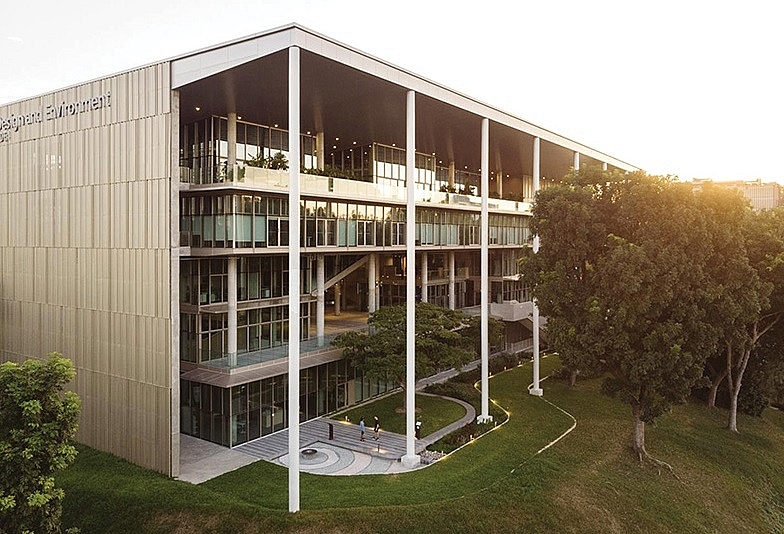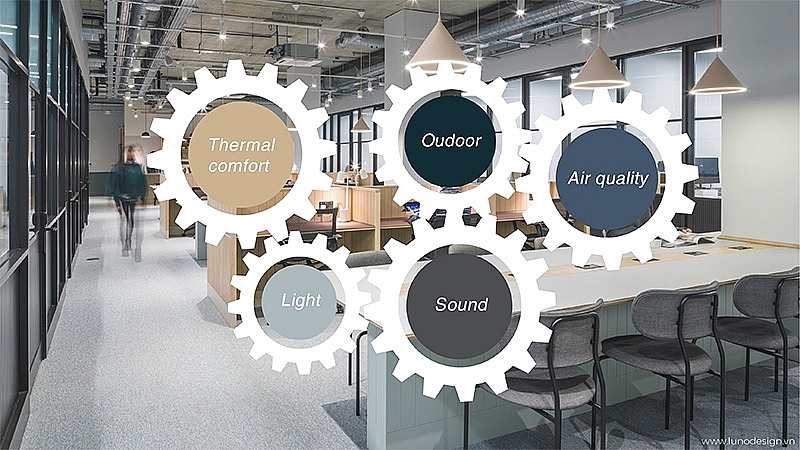Sustainable buildings fit for tomorrow
 |
| Ton Nu Thanh Mai and Nguyen Hong Nhung from the Vietnam Energy Efficiency Network (EEN-Vietnam) |
Up until 2050, the construction sector is estimated to need 13,000 buildings a day on average to cope with demand. In 2018 only, this sector consumed approximately 36 per cent of the world’s energy use. Especially in the face of climate change, environmental pollution, and the decline in cultural diversity, construction has been encountering many more difficulties.
According to the report “Every breath we take: The lifelong impact of air pollution” published at the COP21 Conference, each year there are roughly 4.3 million deaths from indoor air pollution. Meanwhile, the serious outbreak of the COVID-19 pandemic has been a real test of the importance of the quality of living spaces and the health aspects of buildings.
Therefore, it suggests that the question of how buildings ensure overall comfort for users in the face of environmental and climate issues as well as changes in the ways our society operates and develops needs considering.
Extreme interior temperature, limited fresh air supply, low level of soundproofing, and low-level exposure to natural light will seriously hinder both development and health of users. According to a report from the World Green Building Council, the health of family members can be worsened by 50 per cent as well as being susceptible to ills such as headaches, insomnia, depression, and even cancer if they live in a dark home.
Meanwhile, the productivity of office workers, who accounts for 90 per cent of a business’ operating costs, can be reduced by 8-10 per cent when working in an environment with low level of thermal comfort and good lighting.
In Vietnam, a typical example of an uncomfortable building is the 37-storey Danang Administrative Centre. Despite huge investment and a budget of up to VND2 trillion ($86.95 million), after only three years in operation the building has encountered many problems such as lack of air and intensive heat, which have seriously affected the health of more than 1,200 employees working there.
However, in order to meet the needs of today’s construction market, a construction that is considered comfortable should not only provide ideal biological conditions but physical accessibility too. For example, according to the Vietnam General Department of Population, by 2049 a quarter of Vietnam’s population will be aged at least 60 as the country enters a period of very old population. The challenge right now for construction projects is how to make buildings easily accessible without barriers for any aged group, especially those with physical limitations, including elderly individuals.
According to the latest report from the International Energy Agency and the UN, the construction industry will witness a resurgence in growth and the number of constructions will double by 2050. Moreover, the environmental challenges for improving existing buildings and future designs need to focus on four main areas: adaptation to global warming and climate change, exhaustion of resources, pollution, and negativity in land use change.
With an average lifespan of 30-40 years, each building certainly continually impacts its surroundings. Reducing carbon for buildings and construction is a key to achieving the Paris Agreement on Climate Change Action and the UN’s Sustainable Development Goals. In 2018, the operation of buildings and the entire construction sector accounted for 36 per cent of total energy consumption and 39 per cent of CO2 emissions, with 11 per cent of them being the result of the manufacturing process of building materials – especially steel, cement, and glass.
Despite advanced technology and many improvements in operation and repair, the actual amount of global energy has increased by 1 per cent compared to 2017 and 10 per cent compared to 2010. The improvement of energy efficiency for buildings has not yet been enough to overcome the effects of growing demand due to the increase of floor space and urbanisation.
However, energy and emissions are only a part of the pressures on the surrounding environment from the construction sector. In many places, about 50 per cent of the resources of all the non-renewable resources that humans are consuming are used in the construction sector, which makes it one of the largest consumer industries and also the least sustainable one.
 |
 |
| Five factors affecting wellbeing |
Since 1999, more than 60 per cent of processed wood has been used for buildings. For freshwater resources, about 17 per cent of global consumption in 2010 came directly from buildings. According to the life cycle of a building, the amount of waste accounting for about 50 per cent of the total amount of waste is sent to landfills.
Soil surface, groundwater, and biodiversity can be changed and destroyed by unsustainable construction and infrastructure activities. Rapid urbanisation with the majority of the concrete surface contributes to flooding after heavy rain and heat issues in many cities. In many countries, agricultural land has disappeared or been forced to overexploitation due to conversion for urban infrastructure and buildings.
In addition, we also realise pollution of the surrounding environment (air, water, and solids) caused by the processing of waste while producing materials, dust, and noise on site.
Indeed, the construction industry in Vietnam and in the world in general is facing many challenges. However, these difficulties can also turn into advantages and create momentum for strong development of the sustainable construction market if technologies and solutions from traditional one to more modern ones are applied flexibly and collectively.
| The “Building for All. Human – Culture – Environment” programme is being held in Hanoi with a series of exhibitions, seminars, movies, and talks to promote a sustainable construction environment in Vietnam. The programme focuses on the target of maintaining the comfort factor in living areas, honouring the values of culture and environmental friendliness. The initiative comes from the Vietnam Energy Efficiency Network, supported by Goethe-Institut, and co-organised with the UNESCO and Japanese bathroom designers INAX along with communication partner Ashui.com and stakeholders in architecture, construction, and technical solutions. |
What the stars mean:
★ Poor ★ ★ Promising ★★★ Good ★★★★ Very good ★★★★★ Exceptional
Themes: Towards Sustainability
Related Contents
Latest News
More News
- Heavy industries set for pilot greenhouse gas quotas (December 25, 2025 | 10:00)
- Swedfund invests in MSME growth and climate action in Vietnam (December 19, 2025 | 11:42)
- GreenYellow brings solar energy to light up remote schools in Tuyen Quang province (December 19, 2025 | 08:00)
- Charge+, Grab partner to develop EV charging network in Vietnam (December 18, 2025 | 17:11)
- Linking sci-tech and innovation to Vietnam’s net-zero future (December 18, 2025 | 14:31)
- Driving double-digit growth through green and circular transformation in Vietnam (December 17, 2025 | 09:00)
- Standard Chartered and ACCA deepen collaboration to develop Vietnam’s talent for a sustainable future (December 15, 2025 | 18:18)
- Schaeffler reports strong early output from Dong Nai solar project (December 12, 2025 | 15:16)
- Forestry conference highlights biodiversity and sustainability goals (December 09, 2025 | 13:35)
- Home Credit honoured among top 10 sustainable companies in trade and services (December 09, 2025 | 12:18)

 Tag:
Tag:





















 Mobile Version
Mobile Version